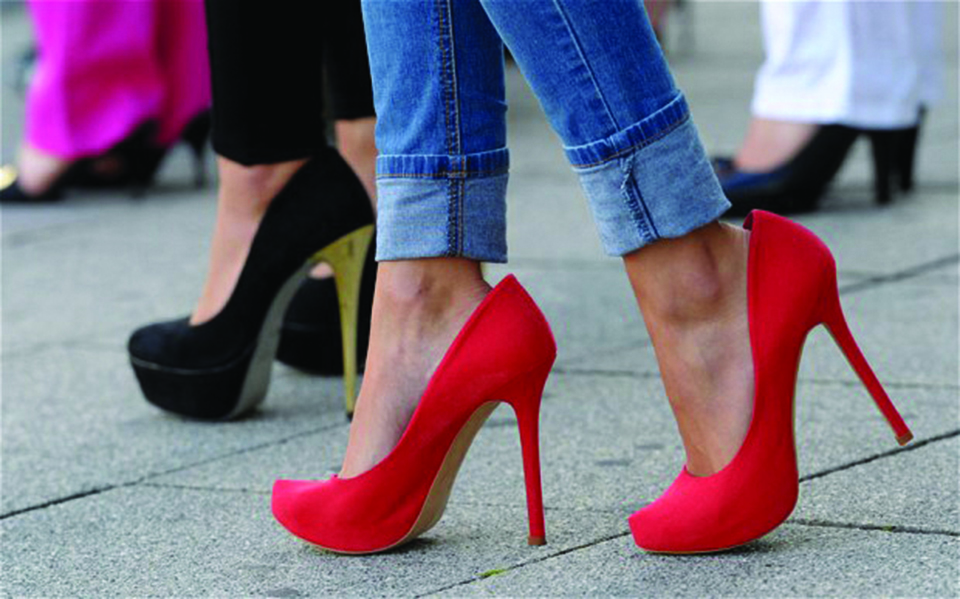
OR


Usha Pokharel
Usha Pokharel is an educationist and author of several children’s books.usha@pokharel.net
During the 16th century wealthy French noblewomen wore heels so high, they were practically standing on their toes
I am sure you have used this expression many times in your life. It is not just an expression we do wear shoes that are comfortable and fit well. It was not always that way. At one time people did not care if the shoe fit or did not. Even till 1850, there was no differentiation between left and right shoe. People wore many kinds of shoes and for most part, a fit shoe was not an issue for a long time. I know some of you remember that Bharat worshipped Ram’s Kharau in Ramayana, and that was a long time ago too and they did have a right foot and left foot. Yes they did and they are also called Charan Paduka: the oldest, most quintessential footwear in our part of the world and was made of wood.
Ancient shoes
Our understanding of ancient shoes here is based on relics, primitive cave wall paintings and mythological scriptures. Would you believe, the first shoe found was a sandal from 10,500 years ago, made of the bark of a sagebrush plant? Later sandals became a status symbol. Yes Pharaoh’s sandals were different from that of a common man’s sandal.
In ancient Egypt, people’s ranks were determined by the kind of sandals they wore.
Aristocrat’s sandals had pointed toes, turned upwards. During the Middle Ages, sandals were replaced by primitive kind of “complete” shoe: a piece of un-tanned animal hide wrapped around the foot tied with a leather thong. Some of you must have come across clogs: wooden shoes from Holland. Clogs are a symbol of Netherlands (Holland). What is even more interesting is, back in 1100s most poor Europeans also wore wooden shoes called sabots. In England and Japan clogs made of fabric, mounted on wooden blocks were very popular. A count’s desire to cover up his deformed feet gave rise to pointed shoes, which became a fashion statement in France. The more pointed the shoe the more fashionable a person was considered.
Gradually the points of the shoes become so long, the toes had to be stuffed so the wearer wouldn’t trip over the ends. I can almost see you laughing your head off. Believe me the situation became so silly, laws had to be passed to limit the length of the shoe points to two inches. Now that’s funny. If you think that as being ridiculous, wait till you read the future development of shoe that pushes the limit of being funny even further. Around 1460-70, the pointed toe was replaced by Duck’s Bill shoes (Bear’s Claw) fad.
This too fell prey to exaggeration. The shoe became broader and broader almost twelve inches in toe width making the wearer waddle. Apparently, to waddle around with big fat floppy clown shoes, was fashionable at the time. Now you can laugh your head off. Around the same time high heels were also becoming very popular.
During the 16th century wealthy French noblewomen wore heels so high, they were practically standing on their toes. Just as other shoe fashions, here also exaggeration played a role, with soles going as high as thirty inches. I cannot even imagine going around in such a high heels. Women in Venice, Italy wore wooden platform shoes as high as stilts and needed help from servants to move around. By 1580, even men wore them, and a person with authority or wealth was often referred to as, “well-heeled”. These were eventually outlawed in Venice after a number of women miscarried after falling off their shoes! Some shoes became popular just because royalties wore them.
New fashion
King Henry VIII of England started the fashion of wide toed shoes to cover his huge feet swollen with gout. Similarly Louise XIV of France wore high-heeled shoes to disguise his short height. The 19th century ushered in the great shoe invention: the last. A foot shaped block fitted with leather and made into a shoe. Now for the first time there was a right foot and left foot, before that all shoes were the same: equally uncomfortable on both feet, referred to as “straights”. Eventually foot specific modern shoes became a standard.
When we talk about shoes, it is difficult to imagine a time before shoes were invented. If we study the history of human development we will find that the importance of protecting the foot was recognized very early. Records of the Egyptians, the Chinese and other early civilizations all contain references to shoes.
Foot covering or shoes were one of the first things made by our primitive ancestors, compelled by necessity to invent some method of protecting their feet from the jagged rocks, burning sands, and rugged terrain they covered looking for food and shelter.
Finally, we’ve come a long way since the invention of shoes, despite the ups and downs in process of its development but its basic structure has not changed much. We are still wearing some form of ancient sandals, and, moccasins worn during middle ages are still available in the form of a loafer. So the next time your child is making a fuss regarding shoe, you can tell them about the history of shoes. I am sure they will enjoy about hearing a little about their footware. After that they are going to have fun deciding if their shoe is a descendent of sandal or moccasins. After all, every child is curious about its shoe’s ancestor. Don’t you think so parents?
The author is an educationist and author of several children’s books
usha@pokharel.net
You May Like This

Summer shoe fashion
Fashion is an art that glimmers to its maximum when complemented with matching accessories. Undoubtedly, the season puts fashion buffs... Read More...

Most valuable player to receive ‘Golden Shoe’ in Ruslan DPL
KATHMANDU, March 26: Ruslan Dhangadhi Premier League (DPL) has extended its contract with the Kiran Shoes Manufacturers’ Gold Star Shoes as... Read More...

London starting line as Adidas laces up robotic shoe run
LONDON,Oct 24: Adidas has launched the first of six planned city-themed running shoe models in London as it capitalizes on its... Read More...




Just In
- Gandaki Province CM assigns ministerial portfolios to Hari Bahadur Chuman and Deepak Manange
- 352 climbers obtain permits to ascend Mount Everest this season
- 16 candidates shortlisted for CEO position at Nepal Tourism Board
- WB to take financial management lead for proposed Upper Arun Project
- Power supply to be affected in parts of Kathmandu Valley today as NEA expedites repair works
- Godepani welcomes over 31,000 foreign tourists in a year
- Private sector leads hydropower generation over government
- Weather expected to be mainly fair in most parts of the country today







_20220508065243.jpg)







Leave A Comment